Learning how to build a shelter is one of the most engaging skills for instructors and students alike. Few other skills under the “primitives” umbrella get you as much bang for your buck. The skill of constructing (and/or finding) a safe, dry, warm place to retreat should be a top priority for everyone, ranging from those who are very focused on emergency survival scenarios where the idea is to live through the immediate future and get back to civilization (protection from the elements is generally one of the first issues you want address) to those who are interested in longer-term wilderness living situations.
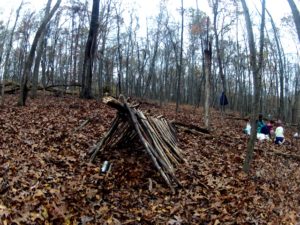 Volumes could be written about different styles of shelter, materials, etc. One of the most basic and frequently taught methods is a simple debris hut, which is essentially a framework of branches that can be covered and filled with layers of debris that shingle (on the outside) and insulate (on the inside). There are dozens of ways to tweak and customize this type of shelter, and it’s the type of shelter we teach most often. So for kids, what are some of the benefits to learning how to build shelter?
Volumes could be written about different styles of shelter, materials, etc. One of the most basic and frequently taught methods is a simple debris hut, which is essentially a framework of branches that can be covered and filled with layers of debris that shingle (on the outside) and insulate (on the inside). There are dozens of ways to tweak and customize this type of shelter, and it’s the type of shelter we teach most often. So for kids, what are some of the benefits to learning how to build shelter?
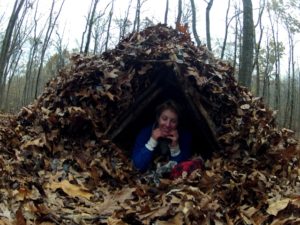 For one thing, it’s a skill that allows a wide range of ages and skill levels to tap into their powers of creativity and imagination. There’s a reason almost all kids love to build forts, and they’re all the better for doing it outside in the fresh air and sunshine instead of indoors where their poor little developing brains are bathing in the ambient noise of television commercials and the harmful compounds off-gassing from paints, carpet, and couch cushions. Building a shelter requires cognitive skills like visualizing, executing plans, problem-solving, and overcoming setbacks. Debris huts are relatively free-form, too. The sky is the limit in terms of finding new ways to fit the pieces together, find new ways to utilize the materials you actually have at hand in different situations, or add features like a lowered entryway that will keep your warm body heat trapped in the inner chamber, a fence of sticks at the base of your walls to trap slumping layers of leaves, or a lean-to/heat shield outside to protect a fire if you have one. The building blocks for shelter are accessible to almost everyone, with little skill or modification necessary. Sticks, leaves, and bark are laying everywhere at your feet, just waiting for kids to imagine and create things out of them, and shelter really helps people of all ages re-establish a creative connection to their environment.
For one thing, it’s a skill that allows a wide range of ages and skill levels to tap into their powers of creativity and imagination. There’s a reason almost all kids love to build forts, and they’re all the better for doing it outside in the fresh air and sunshine instead of indoors where their poor little developing brains are bathing in the ambient noise of television commercials and the harmful compounds off-gassing from paints, carpet, and couch cushions. Building a shelter requires cognitive skills like visualizing, executing plans, problem-solving, and overcoming setbacks. Debris huts are relatively free-form, too. The sky is the limit in terms of finding new ways to fit the pieces together, find new ways to utilize the materials you actually have at hand in different situations, or add features like a lowered entryway that will keep your warm body heat trapped in the inner chamber, a fence of sticks at the base of your walls to trap slumping layers of leaves, or a lean-to/heat shield outside to protect a fire if you have one. The building blocks for shelter are accessible to almost everyone, with little skill or modification necessary. Sticks, leaves, and bark are laying everywhere at your feet, just waiting for kids to imagine and create things out of them, and shelter really helps people of all ages re-establish a creative connection to their environment.
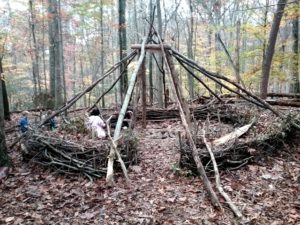 Building shelter can also be a real ice-breaker for students who aren’t as comfortable in natural settings. Some kids are even squeamish about simply sitting in leaf litter or on the ground when they first find themselves in the great outdoors. Next thing you know, they’re having a blast working in teams to rake up giant piles of leaves (and jump into them), gather sticks and branches, and peel up dead bark in sheets. The trick is to take what would normally be a chore, and transform it into play. It can be a social activity where everyone collaborates, building up each other’s strengths and compensating for their weaknesses. Making a shelter really helps people get over any hang-ups and break down any barriers they see between themselves and the natural world, because before too long you’re covered with nature in the form of “dirt” and leaf duff, and, lo and behold, it’s fun. According to the hygeine hypothesis, getting all this crud on you is actually beneficial to your health and immune function, and missing out of the experience of slathering yourself in benign and beneficial symbionts (bacteria and other) can be detrimental.
Building shelter can also be a real ice-breaker for students who aren’t as comfortable in natural settings. Some kids are even squeamish about simply sitting in leaf litter or on the ground when they first find themselves in the great outdoors. Next thing you know, they’re having a blast working in teams to rake up giant piles of leaves (and jump into them), gather sticks and branches, and peel up dead bark in sheets. The trick is to take what would normally be a chore, and transform it into play. It can be a social activity where everyone collaborates, building up each other’s strengths and compensating for their weaknesses. Making a shelter really helps people get over any hang-ups and break down any barriers they see between themselves and the natural world, because before too long you’re covered with nature in the form of “dirt” and leaf duff, and, lo and behold, it’s fun. According to the hygeine hypothesis, getting all this crud on you is actually beneficial to your health and immune function, and missing out of the experience of slathering yourself in benign and beneficial symbionts (bacteria and other) can be detrimental.
At the end of the day, few things can make you feel as “at home” in nature as…well, making a home in nature. It bolsters confidence, beefs up critical thinking skills, makes people more aware of the utility and presence of natural materials around them, makes them more effective and clever at using those natural materials, gives people a sense of agency and capability in their environment, and can bring them together for a darn good time.
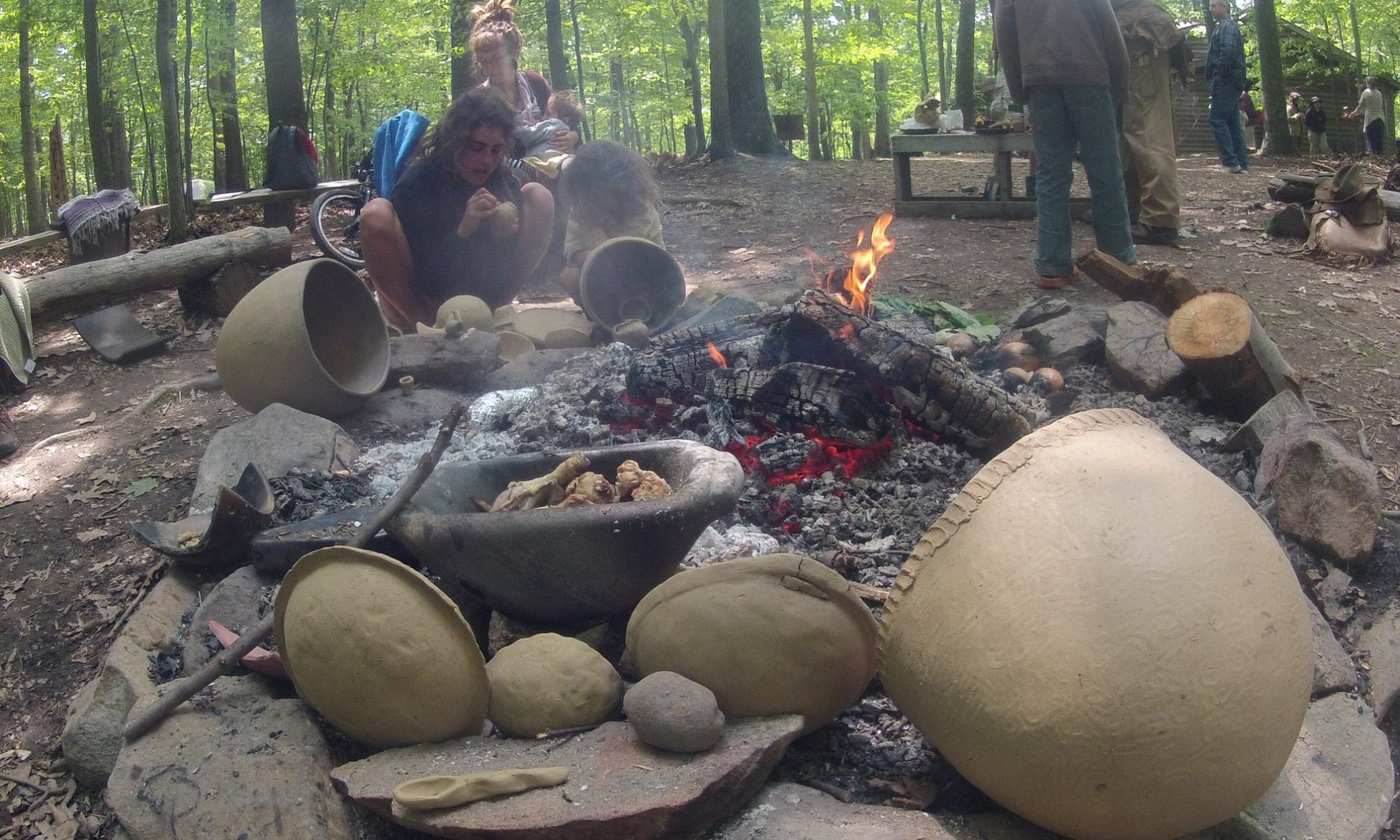







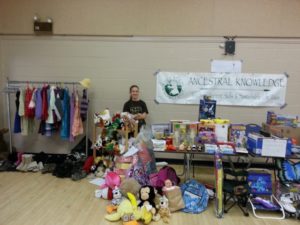 We were so excited to hear that one of our homeschool students loved our program so much that she wanted to host a fundraiser for the AK Send-a-Kid-to-Camp fund as her community service project.
We were so excited to hear that one of our homeschool students loved our program so much that she wanted to host a fundraiser for the AK Send-a-Kid-to-Camp fund as her community service project.

